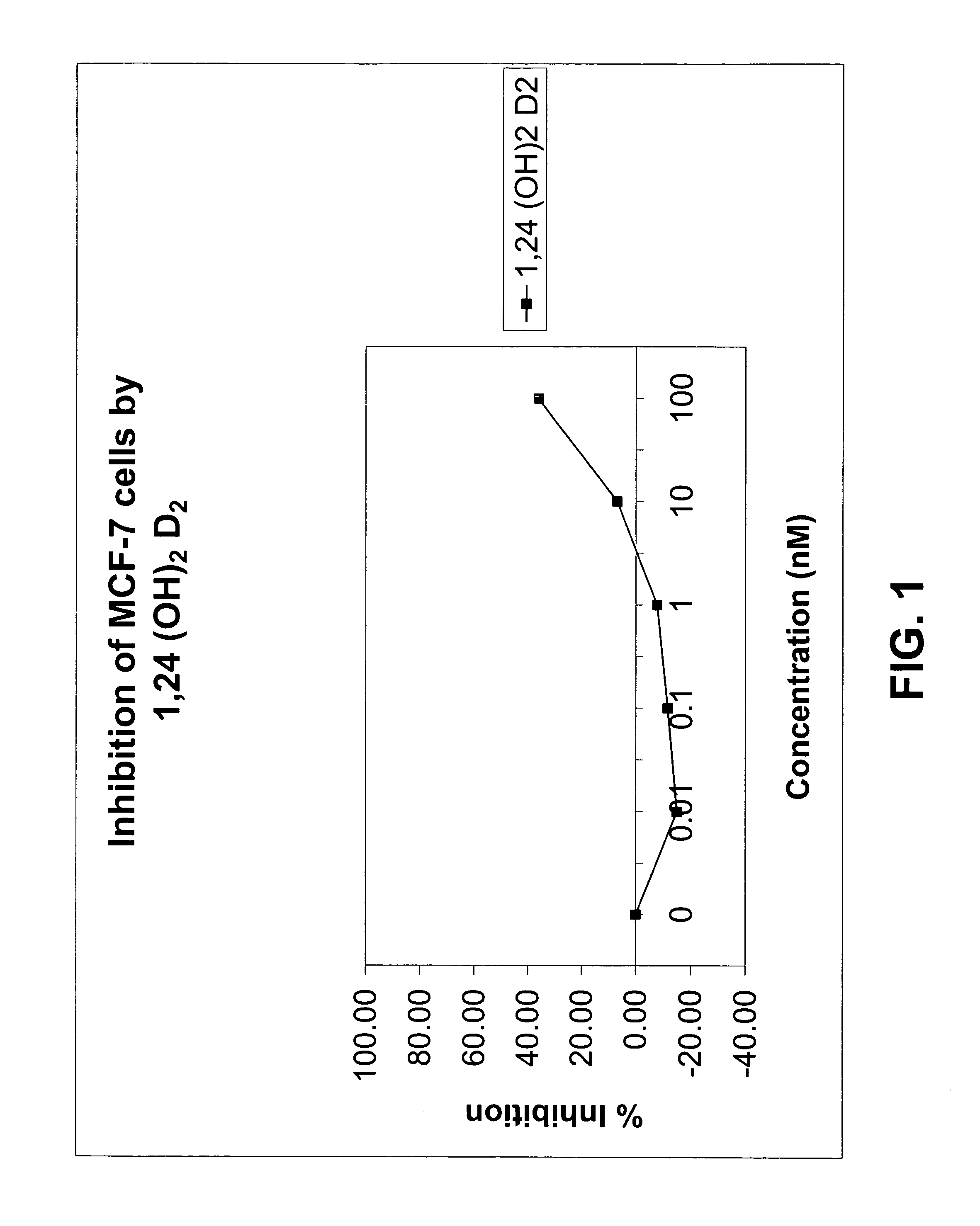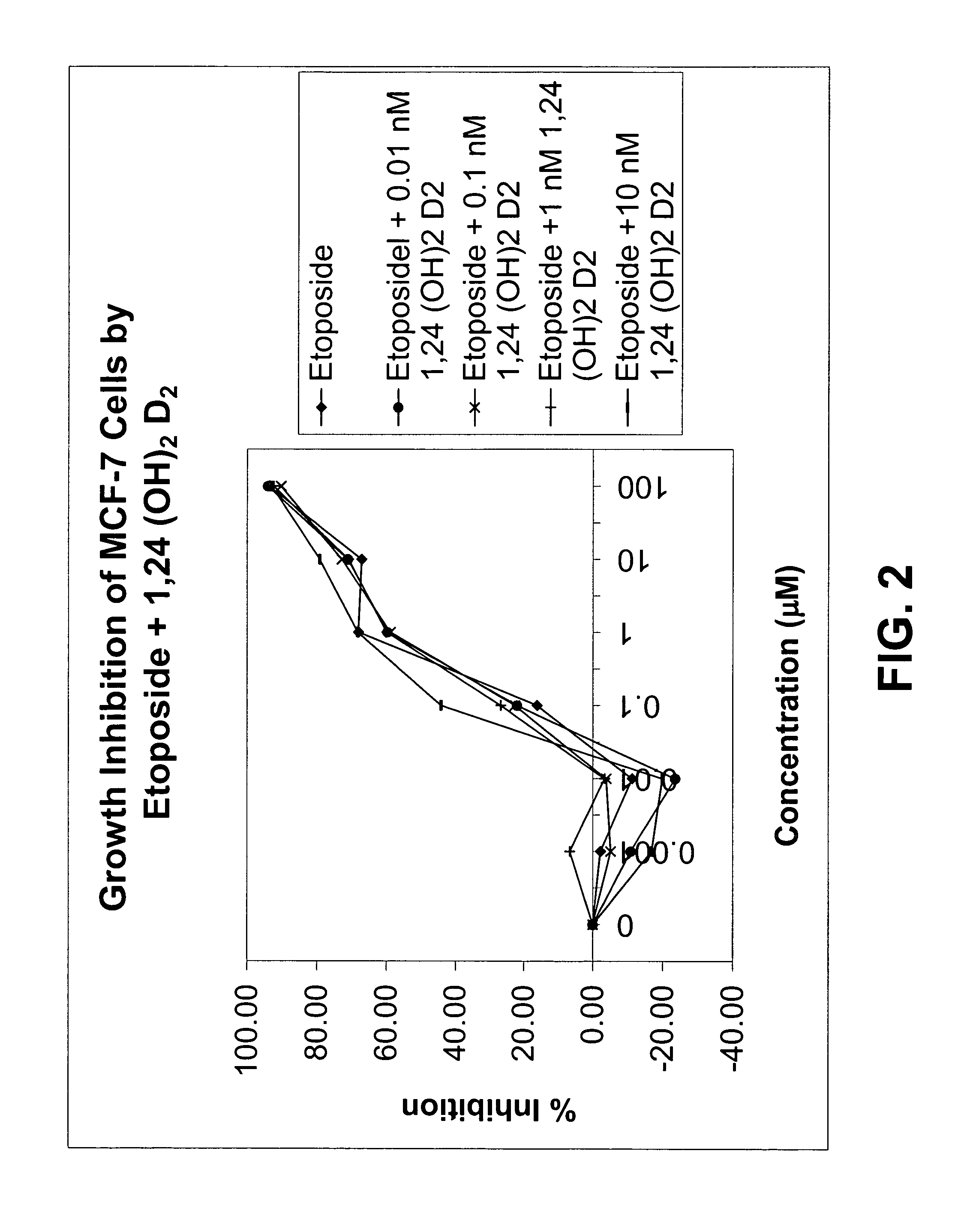Method of treating breast cancer using a combination of vitamin D analogues and other agents
a technology of vitamin d and analogues, applied in the field of breast cancer treatment using a combination of vitamin d analogues and other agents, can solve the problems of poor treatment, no universally successful method for the prevention or treatment of breast cancer is currently available, no long-term treatment effective for breast cancer, etc., to achieve the effect of promoting or enhancing cell differentiation, reducing the risk of breast cancer, and improving the therapeutic index of activ
- Summary
- Abstract
- Description
- Claims
- Application Information
AI Technical Summary
Benefits of technology
Problems solved by technology
Method used
Image
Examples
example 1
1α,24-dihydroxyvitamin D2 [1α,24-(OH)2D2]
[0080]The affinity of 1α,24-(OH)2D2 for the mammalian vitamin D receptor (VDR) was assessed using a commercially available kit of bovine thymus VDR and standard 1,25-(OH)2D3 solutions from Incstar (Stillwater, Minn.). The half-maximal binding of chemically synthesized 1α,24-(OH)2D2 was approximately 150 pg / ml whereas that of 1α,25-(OH)2D3 was 80 pg / ml. Thus, the 1α,24-(OH)2D2 had a very similar affinity for bovine thymus VDR as did 1α,25-(OH)2D3, indicating that 1α,24-(OH)2D2 has potent biological activity.
example 2
1α,24-dihydroxyvitamin D2 [1α,24-(OH)2D2]
[0081]VDR binding of vitamin D compounds by breast cells is demonstrated using the techniques of Skowronski et al., 136 Endocrinology (1995) 20–26, which is incorporated herein by reference. Breast-derived cell lines are cultured to near confluence, washed and harvested by scraping. Cells are washed by centrifugation, and the cell pellet resuspended in a buffered salt solution containing protease inhibitors. The cells are disrupted by sonication while cooling on ice. The supernatant obtained from centrifuging the disrupted cells at 207,000×g for 35 min at 4° C. is assayed for binding. 200 μL of soluble extract, (1–2 mg protein / ml supernatant) is incubated with a 1 nM 3H-1α,25-(OH)2D3 and increasing concentrations of 1α,24-(OH)2-D2 (0.01–100 nM) for 16–20 hr at 4° C. Bound and free hormones are separated with hydroxylapatite using standard procedures. Specific binding is calculated by subtracting nonspecific binding obtained in the presence of...
example 3
1α,24(S)-dihydroxyvitamin D2 and 1α,24(R)-dihydroxy-vitamin D2 1α,24(S)-(OH)2D2 and 1α,24(R)-(OH)2D2]
[0082]Using the plasmids pSG5-hVDR1 / 3, a vitamin D receptor (VDR)-expressing plasmid, and p(CT4)4TKGH, a plasmid containing a Growth Hormone (GH) gene, under the control of a vitamin D-responsive element (VDRE), experiments were conducted to explore the ability of 1α,24-(OH)2D2 to induce vitamin D-dependent growth hormone acting as a reporter gene compared to that of 1α,25-(OH)2D3. Cells in culture were co-transfected into Green monkey kidney, COS-1 cells with these two plasmids. One plasmid contained the gene for Growth Hormone (GH) under the control of the vitamin D responsive element (VDRE) and the other plasmid contained the structural gene for the vitamin D receptor (VDR). These transfected cultures were incubated with 1α,24-(OH)2D2 or 1α,25-(OH)2D3, and the production of growth hormone was measured.
[0083]As shown in Table 2, both 1α,24(S)-(OH)2D2 and its epimer, 1α,24(R)-(OH)2D...
PUM
| Property | Measurement | Unit |
|---|---|---|
| size | aaaaa | aaaaa |
| temperature | aaaaa | aaaaa |
| compositions | aaaaa | aaaaa |
Abstract
Description
Claims
Application Information
 Login to View More
Login to View More - R&D
- Intellectual Property
- Life Sciences
- Materials
- Tech Scout
- Unparalleled Data Quality
- Higher Quality Content
- 60% Fewer Hallucinations
Browse by: Latest US Patents, China's latest patents, Technical Efficacy Thesaurus, Application Domain, Technology Topic, Popular Technical Reports.
© 2025 PatSnap. All rights reserved.Legal|Privacy policy|Modern Slavery Act Transparency Statement|Sitemap|About US| Contact US: help@patsnap.com



